Martian Chess - Control Territory not Pieces
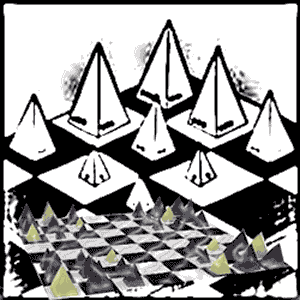
Chess Variant - Martian Chess
These nine pieces will not stay under the control of the player they start with. They are controlled by the player whose territory they move into. When you move a piece into someone else's quadrant, it is no longer your piece. That piece now belongs to your opponent. Equally any piece that is moved into your territory becomes your piece.
The first move is decided by agreement and then continues clockwise. The game ends when one player's territory is empty. At that point each player counts up their points, accumulated by the pieces you've captured during the game. It's three points for each queen you've captured, two points for each drone and one point for each pawn. The player with the most points wins the game. You can talk to us about Martian Chess.
History
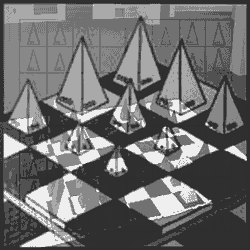
Martian Chess was developed in the mid-90s by Andrew Looney
Looney Labs has developed many strategy games. They created what they call Icehouse pieces that they use for their board games including Martian Chess.
They were called Icehouse pieces because Icehouse was the first Looney Labs game they were used for. They are actually officially called Looney Pyramids. They have a futuristic, final frontier feel to them. The Looney chess variant is played with these pieces and a number of different game boards, including the traditional 8x8, depending on the number of players.
Rules - Intro

The entire 8x8 chess board is used in a four player game, only half a board for a two player game. For every player in the game there must be 16 squares.
The game ends when someone runs out of pieces. The player who accumulates the most points, calculated by captured pieces, is the winner. Each player starts by setting up nine Looney Pyramids (Icehouse pieces), three of each size, in his quadrant of the board, as shown in the image.
The large pieces (Queens) may move in any direction, straight or diagonally, with unlimited range. The medium pieces (Drones) move only on straight paths (never diagonally) one or two spaces at a time. The small pieces (pawns) move one space at a time, diagonally in any direction. No piece can jump over another piece.
Rules - Board and Pieces
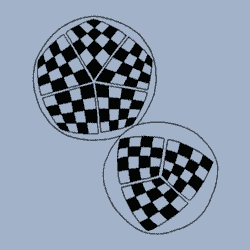
Martian Chess boards for 5 player games and 3 player games
The 64 square board when used for the main variant is split into four 4x4 quadrants. Perpendicular lines called canals intersect in the center to mark these quadrants. Each player will take control of one of these quadrants for the entire game and will have control of any piece that is located in that quadrant.
Color is means nothing in this game. The way you know which pieces you control is determined instead by the location of the pieces at any given moment. Any piece in your zone is yours, only you can move it. When you move a piece across a canal, it becomes your opponent's piece. You capture an enemy piece by moving your piece onto its square. Whenever you capture, you give control of your piece to the opponent whose piece you took. To learn more about the various boards try MC Boards.
Rules - General
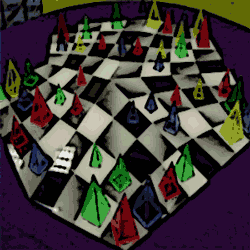
Martian Chess for five players in full swing
If you have no Drones you can merge 2 pawns in the same way. The game ends as soon as one player runs out of pieces by emptying his quadrant of the board. A player with only one piece remaining can force the end of the game by moving that piece across a canal.
A player may not reject the move of the opponent. If a player moves a piece across the canal, the opponent cannot simply move it back to its original square. If Player 1 moves a Queen from square A (in his zone) to square B (in Player 2's zone), Player 2 can't just move it back to square A.
He can move it to any other square, but can't simply "reject" Player 1's move. He can move it back to square A later on, because the rule only applies to a pair of sequential moves. The most detailed account of the rules can be found at Looney Labs.
Strategy
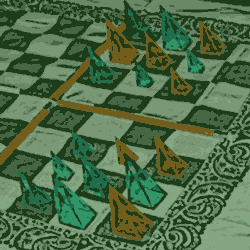
Martian Chess for Two: Just use half of a regular chess board
Remember the Bottom Line. Keep in mind that the goal is points, not position. There is no checkmate. This is particularly vital in a 4 player game, when 2 people can use the Double Whammy on each other to quickly trade pieces for points.
Run For The Border. If you're ahead on points and low on pieces, try to end the game quickly by pushing your last few pieces across a canal.
Play
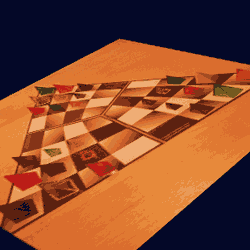
You need a Triad design board when playing Martian Chess for Three
There's a little bit of strategy to keep in mind as you decide which captures help your cause and which ones play into your adversary's hands. After a few games you should no doubt be on your way to becoming a Martian shark!
You'll be happy to discover that you can download this game at Board Game Geek.
Talk About the Great Game of Martian Chess
Have you played this Martian variant? What did you think of it? Are you hooked? Tell us about your experiences with it. Do you have a great story about this? Share it!
Moving On

Sittuyin
In Western chess players develop their pieces to outposts in well worn opening systems. Sittuyin players simply place their pieces anywhere behind their pawns.
The pawns are placed on a3, b3, c3, d3, e4, f4, g4 and h4 for Black playing up the board. Red playing down the board starts his pawns on a5, b5, c5, d5, e6, f6, g6 and h6.
Sittuyin historically had many local variants from region to region. This could be one of the main reasons why it has largely been replaced in Burma by Western Chess.






